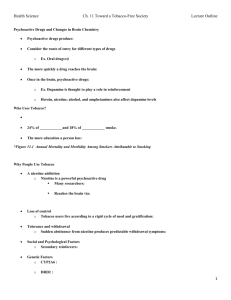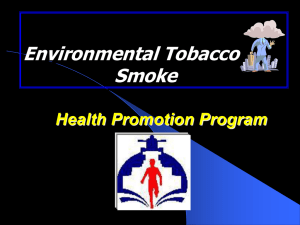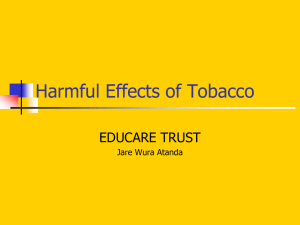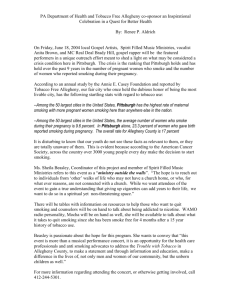Chapter 14 Study Guide
advertisement
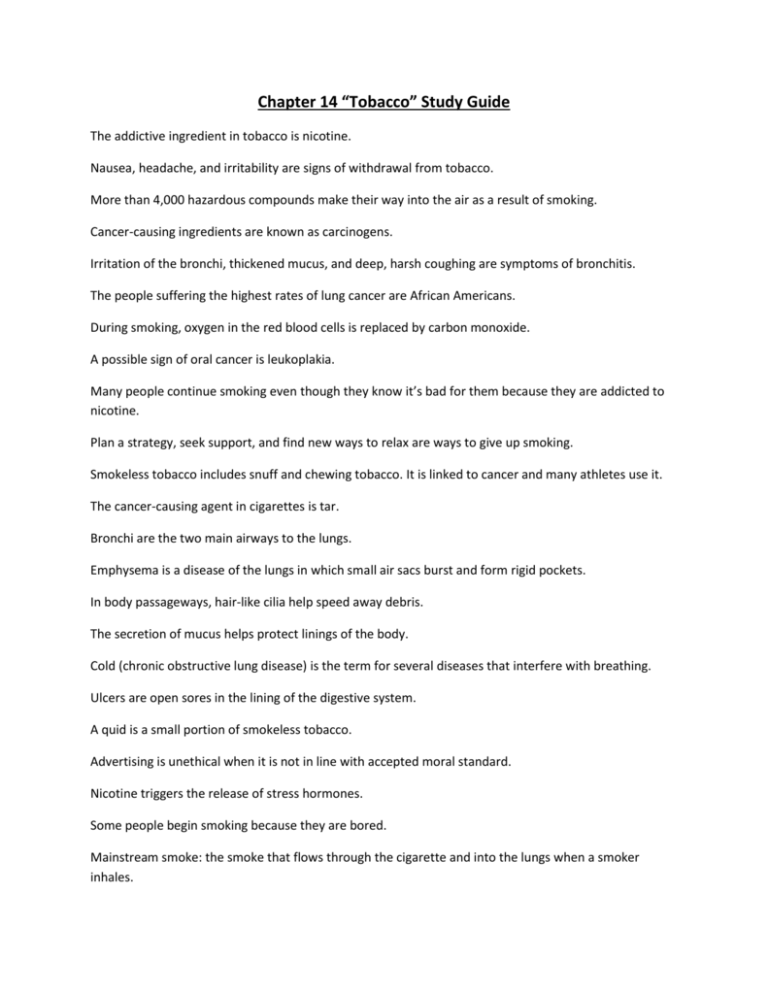
Chapter 14 “Tobacco” Study Guide The addictive ingredient in tobacco is nicotine. Nausea, headache, and irritability are signs of withdrawal from tobacco. More than 4,000 hazardous compounds make their way into the air as a result of smoking. Cancer-causing ingredients are known as carcinogens. Irritation of the bronchi, thickened mucus, and deep, harsh coughing are symptoms of bronchitis. The people suffering the highest rates of lung cancer are African Americans. During smoking, oxygen in the red blood cells is replaced by carbon monoxide. A possible sign of oral cancer is leukoplakia. Many people continue smoking even though they know it’s bad for them because they are addicted to nicotine. Plan a strategy, seek support, and find new ways to relax are ways to give up smoking. Smokeless tobacco includes snuff and chewing tobacco. It is linked to cancer and many athletes use it. The cancer-causing agent in cigarettes is tar. Bronchi are the two main airways to the lungs. Emphysema is a disease of the lungs in which small air sacs burst and form rigid pockets. In body passageways, hair-like cilia help speed away debris. The secretion of mucus helps protect linings of the body. Cold (chronic obstructive lung disease) is the term for several diseases that interfere with breathing. Ulcers are open sores in the lining of the digestive system. A quid is a small portion of smokeless tobacco. Advertising is unethical when it is not in line with accepted moral standard. Nicotine triggers the release of stress hormones. Some people begin smoking because they are bored. Mainstream smoke: the smoke that flows through the cigarette and into the lungs when a smoker inhales. Sidestream smoke: the smoke that escapes into the air from the burning tip of a cigarette or cigar, or form burning pipe tobacco. Environmental Tobacco Smoke (ETS): the combination of exhaled mainstream smoke and sidestream smoke that enters the air and may be inhaled by other people. Prune juice, raisin juice, cocoa, and licorice are additives used to flavor cigarettes. In emphysema death is from slow suffocation. Smokers have higher rates of cancer of the bladder, pancreas, and kidney than do nonsmokers. Nicotine doesn’t help dissolve blood clots in the arteries. Smoking one-and-a-half packs of cigarettes a day has the same effects as having 300 chest X-rays. Smoking is the single greatest cause of preventable death in the United States today. More than 3,000 teenagers become regular smokers each day. Passive smoking is not good for you and it does contribute to fatalities. People who are trying to quit smoking find it helps to discover what they enjoy most about it and try to find substitutes. Tars reduce the lungs’ ability to supply oxygen; nicotine increases the heart’s need for oxygen. The key to helping is “tough love” a term borrowed from alcoholism treatment.





